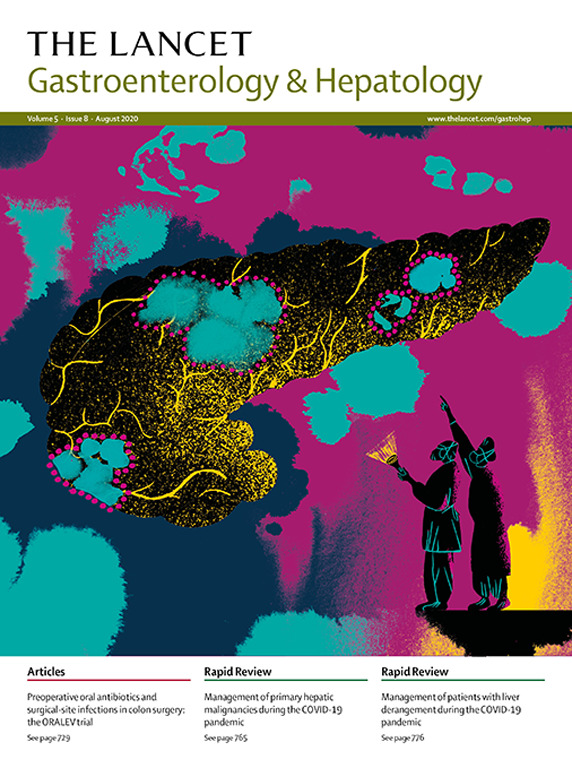Denifanstat for the treatment of metabolic dysfunction-associated steatohepatitis: a multicentre, double-blind, randomised, placebo-controlled, phase 2b trial
IF 30.9
1区 医学
Q1 GASTROENTEROLOGY & HEPATOLOGY
引用次数: 0
Abstract
Background
Denifanstat, an oral fatty acid synthase (FASN) inhibitor, blocks de-novo lipogenesis, a key pathway driving progressive lipotoxicity, inflammation, and fibrosis in metabolic dysfunction-associated steatohepatitis (MASH). This study aimed to examine the safety and efficacy of denifanstat for improving liver histology in individuals with MASH and moderate to advanced fibrosis.Methods
This multicentre, double-blind, randomised, placebo-controlled, phase 2b trial was conducted at 100 clinical sites in the USA, Canada, and Poland. After a screening period of up to 90 days, participants aged 18 years and older with biopsy-confirmed MASH and stage F2 or F3 fibrosis were randomly assigned (2:1) to receive either 50 mg oral denifanstat or placebo once per day for 52 weeks. Participants were dynamically allocated to treatment groups via a centrally administered interactive web-based response system and stratified by type 2 diabetes, region, and fibrosis stage. Investigators, patients, and the sponsor were masked to group allocation until database lock. The primary efficacy endpoints were a 2-point or greater improvement in non-alcoholic fatty liver disease activity score (NAS) without a worsening of fibrosis or MASH resolution with a 2-point or greater improvement in NAS without a worsening of fibrosis at week 52, assessed by intention to treat. Safety was assessed in all participants who received at least one dose of study drug. This trial is registered with ClinicalTrials.gov, NCT04906421, and is closed for enrolment.Findings
Of the 1087 individuals screened between June 2, 2021, and June 28, 2022, 168 eligible participants were randomly assigned to receive a dose of 50 mg denifanstat once per day (n=112) or placebo (n=56). All 168 participants (100 female, 68 male) received at least one dose of study treatment. In the ITT population, 42 (38%) of 112 participants in the denifanstat group had a 2-point or greater improvement in NAS without a worsening of fibrosis versus nine (16%) of 56 participants in the placebo group (common risk difference 21·0%, 95% CI 8·1–33·9; p=0·0035). 29 (26%) of 112 participants in the denifanstat group showed MASH resolution with a 2-point or greater improvement in NAS without a worsening of fibrosis compared with six (11%) of 56 participants in the placebo group (common risk difference 13·0%, 0·7–25·3; p=0·0173). The most common treatment-emergent adverse events were COVID-19 (19 [17%] of 112 in the denifanstat group vs six [11%] of 56) in the placebo group, dry eye symptoms (ten [9%] of 112 vs eight [14%] of 56), and alopecia (21 [19%] of 112 vs two [4%] of 56). All adverse events considered to be related to the study drug were of grade 1 or grade 2. None of the serious adverse events (13 [12%] of 112 participants in the denifanstat group vs three [5%] of 56 in the placebo group) were considered drug-related.Interpretation
Treatment with denifanstat resulted in statistically significant and clinically meaningful improvements in disease activity, MASH resolution, and fibrosis. The results of this phase 2b trial support the advancement of denifanstat to phase 3 development.Funding
Sagimet Biosciences.治疗代谢功能障碍相关性脂肪性肝炎的地尼凡司特:一项多中心、双盲、随机、安慰剂对照的 2b 期试验
背景地尼凡司他是一种口服脂肪酸合成酶(FASN)抑制剂,可阻断新生脂肪生成,而新生脂肪生成是代谢功能障碍相关性脂肪性肝炎(MASH)中驱动渐进性脂肪毒性、炎症和纤维化的关键途径。这项研究旨在考察地尼凡司特改善MASH和中晚期肝纤维化患者肝脏组织学的安全性和有效性。方法这项多中心、双盲、随机、安慰剂对照的2b期试验在美国、加拿大和波兰的100个临床基地进行。经过长达90天的筛选期后,年龄在18岁及以上、活检证实患有MASH和F2或F3期纤维化的参与者被随机分配(2:1)接受50毫克口服地尼司他或安慰剂治疗,每天一次,为期52周。参与者通过中央管理的交互式网络响应系统动态分配到治疗组,并按 2 型糖尿病、地区和纤维化分期进行分层。在数据库锁定之前,研究人员、患者和赞助商都不知道治疗组的分配情况。主要疗效终点是非酒精性脂肪肝活动评分(NAS)改善2分或更多,且纤维化不恶化,或MASH缓解2分或更多,且第52周时NAS改善2分或更多,纤维化不恶化。对所有接受过至少一剂研究药物的参与者进行了安全性评估。研究结果在2021年6月2日至2022年6月28日期间筛选出的1087名参与者中,168名符合条件的参与者被随机分配接受每天一次50毫克地尼凡司特(n=112)或安慰剂(n=56)。所有 168 名参与者(100 名女性,68 名男性)都接受了至少一次治疗。在ITT人群中,地尼凡司特组112名参与者中有42人(38%)的NAS改善了2点或更多,且纤维化没有恶化,而安慰剂组56名参与者中有9人(16%)的NAS改善了2点或更多(常见风险差异21-0%,95% CI 8-1-33-9;P=0-0035)。在地尼凡司特治疗组的112名参与者中,有29人(26%)的MASH症状得到缓解,NAS改善2分或更多,且纤维化没有恶化,而安慰剂治疗组的56名参与者中,有6人(11%)的MASH症状得到缓解(常见风险差异为13-0%,0-7-25-3;p=0-0173)。最常见的治疗突发不良事件是COVID-19(地尼凡司他组112人中有19人[17%],安慰剂组56人中有6人[11%])、干眼症状(112人中有10人[9%],56人中有8人[14%])和脱发(112人中有21人[19%],56人中有2人[4%])。所有被认为与研究药物有关的不良反应均为 1 级或 2 级。所有严重不良事件(地尼凡司他组112人中有13人[12%],安慰剂组56人中有3人[5%])均与药物无关。这项 2b 期试验的结果支持将地尼凡司他推进到 3 期开发。
本文章由计算机程序翻译,如有差异,请以英文原文为准。
求助全文
约1分钟内获得全文
求助全文
来源期刊

Lancet Gastroenterology & Hepatology
Medicine-Hepatology
CiteScore
50.30
自引率
1.10%
发文量
0
期刊介绍:
The Lancet Gastroenterology & Hepatology is an authoritative forum for key opinion leaders across medicine, government, and health systems to influence clinical practice, explore global policy, and inform constructive, positive change worldwide.
The Lancet Gastroenterology & Hepatology publishes papers that reflect the rich variety of ongoing clinical research in these fields, especially in the areas of inflammatory bowel diseases, NAFLD and NASH, functional gastrointestinal disorders, digestive cancers, and viral hepatitis.
 求助内容:
求助内容: 应助结果提醒方式:
应助结果提醒方式:


